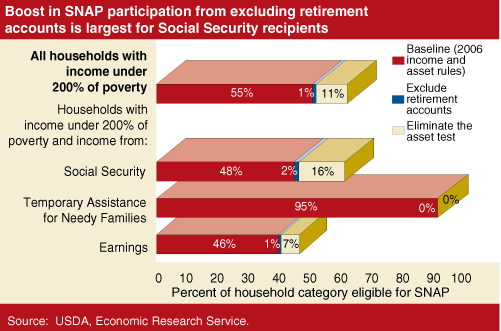2008 Farm Act Makes It Easier for Food Assistance Households To Save
- by Margaret Andrews
- 11/1/2008
USDA’s Supplemental Nutrition Assistance Program (SNAP), formerly known as the Food Stamp Program, helps low-income households maintain a nutritious diet and meet other expenses when their budgets are strained. To qualify for benefits, however, households cannot exceed program-specified resource limits. Some households must first draw down their savings until their financial assets fall below program-defined limits.
The recently enacted Food, Conservation, and Energy Act of 2008 (Farm Act) includes new provisions that make it easier for participating households to save, especially for education or retirement. For the first time since they were set in 1985, the asset limits that determine program eligibility will be adjusted annually for inflation in increments of $250. The first change is expected to occur in 2012. Also, assets held in all tax-qualified retirement and education accounts (such as Individual Retirement Accounts (IRAs) and 529 Education Accounts) will not count against eligibility.
Currently, households with more than $2,000 in countable assets are excluded from participating in SNAP. (The limit is $3,000 if any household members are elderly or disabled.) Assets counted toward the limit include cash on hand, savings and checking accounts, stocks, bonds, and real estate not used as a home residence or for producing income. Automobiles worth more than $4,650 were countable, but by November 2007, all States had acted to exclude one or all personal vehicles or raise the exempted value.
ERS-funded research estimates that, in 2006, about 55 percent of households with incomes under 200 percent of the poverty level were eligible for food stamp benefits given then-existing income and asset requirements. The asset requirements had less of an effect on food stamp eligibility for households receiving Temporary Assistance for Needy Families (TANF) benefits than for households receiving Social Security benefits or with an elderly household member.
Eliminating asset limits altogether would have expanded food stamp eligibility by about 22 percent for the general population in 2006, but would not have appreciably increased eligibility for those receiving TANF. Based on 2006 data, an additional 354,000 households (slightly more than a 2-percent increase) will become eligible for SNAP benefits as a result of the 2008 Farm Act’s exclusion of retirement accounts. Data were not available to estimate the effect of eliminating tax-qualified educational accounts.
In addition to increases in eligibility, the 2008 asset rules reduce disincentives to save that will affect not just the newly eligible, but future participants and the more than 28 million current participants. Although the effects of these changes on savings are difficult to estimate, the new asset rules are consistent with the goal of improving the self-sufficiency of low-income Americans.


